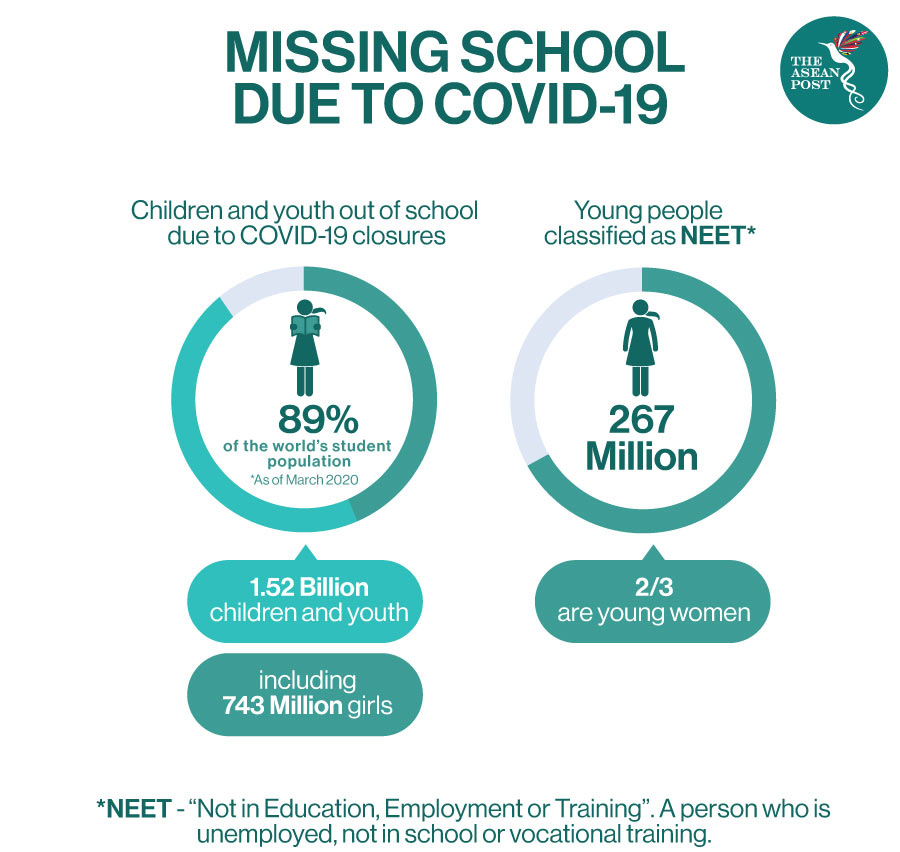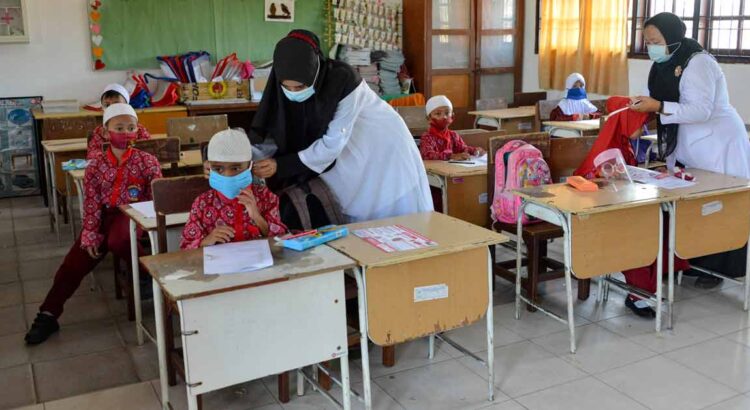Is It Safe For Children To Go Back To School?
Athira Nortajuddin
Teachers put face masks on students as a preventive measure against the COVID-19 coronavirus at an elementary school in Banda Aceh. (AFP Photo)
Back in November, the Indonesian government instructed all schools to be ready to reopen in January 2021. But the Indonesian Paediatric Society (IDAI) stated that reopening schools will lead to an increase in COVID-19 cases in the country. The group believes that virtual learning is the safest learning method for now.
Nevertheless, Nadiem Makarim, the archipelago’s Education and Culture Minister said that parents are free to determine whether to allow their children to go back to school or not.
In neighbouring Malaysia, the Ministry of Education announced that all educational institutions across the country will reopen on 20 January, 2021 after a nationwide closure since early November. The announcement however was met with mixed opinions as expressed by Malaysians on social media.
On one hand, unsurprisingly, parents are worried about sending their kids to school with Malaysia reporting some 1,000 to over 2,000 new cases of COVID-19 every day in recent months. On the other hand, some observers commented about the irony of parents bringing their children out in public but remain afraid to send them back to school.
The debate on reopening schools is not exclusive to Southeast Asian countries, but in other regions as well.
In the United Kingdom (UK), rows continue over whether pupils should return to school given the current virus restrictions as many of England’s primary schools are re-opening today. Nevertheless, UK Prime Minister Boris Johnson has urged parents to send their kids to school, adding that the risk was “very, very low.” But some parents are still unconvinced.
Education In A Pandemic
As of April 2020, when governments were still scrambling to contain the coronavirus, 188 countries around the world had imposed nationwide school closures, affecting over one billion pupils. Today, although some countries have eased virus restrictions, over 100 million learners worldwide are still affected.

School closures have caused the world’s children to face an “unprecedented education emergency,” according to Save the Children as almost 10 million kids may never return to school following the devastating health crisis.
Shuttered schools have also shifted face-to-face learning to e-learning where classes and lectures are conducted online such as via Zoom or Google Classroom. However, as not everyone has the luxury to access the internet or even own learning equipment such as a computer – COVID-19 has indeed deepened the digital education divide worldwide.
Girls particularly are vulnerable to the impacts of education disruption caused by school closures.
According to the United Nations Children’s Fund (UNICEF) as referenced in an article titled, ‘COVID-19 Leaves Millions of Girls at Risk of School Dropout in Asia-Pacific’ published in November – 20 percent of girls in East Asia and Pacific, close to 40 million of them in total, have not been able to access distance learning amid the pandemic and 69 percent of girls reported studying and learning less than usual.
Other than that, learning online in an informal setting at home can also affect students’ concentration and focus. Some may even resort to dropping out as they have lost interest in learning.
Malaysia has reported an increase in dropout rates among children at primary and secondary levels in 2020 – since the beginning of the pandemic. A 2020 survey jointly commissioned by the United Nations Population Fund (UNFPA) and UNICEF which aimed to evaluate the socio-economic state of households in low-cost flats in the nation’s capital city of Kuala Lumpur found that one out of five respondents said that their children had lost interest in school or are demotivated during the pandemic.
Therefore, it isn’t entirely a surprise that some parents are eager to send their children back to school to resume their education.
“Parents and students want schools to reopen and children back in school with much more stringent SOPs, including providing face masks to those who cannot afford them,” Tunku Munawirah Putra, honorary secretary of the Parent Action Group for Education Malaysia (PAGE) told local media.
“Some students may not be able to follow online learning, which makes them completely disinterested in schooling and learning,” she added.
Musa Nordin, a Malaysian consultant paediatrician and neonatologist also said that children rarely had severe symptoms of infection, were less likely to transmit the virus and were rarely responsible for household transmissions. However, he stressed that children should be taught basic precautions such as hand hygiene and physical distancing for them to practise at school.
In Vietnam when school reopened for the new academic year back in September, precautionary measures against COVID-19 including temperature checks and maintaining a safe distance were strictly imposed. Prior to the opening, schools conducted disinfection on the whole campus and classrooms, and were equipped with items like hand sanitizers, thermometers, medicine and face masks among other medical supplies.
«None of us can assume that this or that area is completely free of COVID-19, but we still have to continue our lives and kids need to head back to school with new normalcy,» said Le Bao Chau, the Vietnamese mother of a fourth grader.
In the UK, when asked if schools and nurseries should be re-opened or remain closed, Gemma Cocker told local media that “morally, I think they should close, but practically, no. It’s a hard one.”
Fuente de la Información: https://theaseanpost.com/article/it-safe-children-go-back-school








 Users Today : 28
Users Today : 28 Total Users : 35460159
Total Users : 35460159 Views Today : 42
Views Today : 42 Total views : 3418825
Total views : 3418825